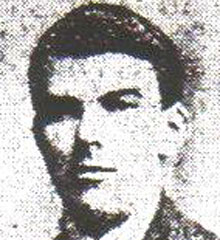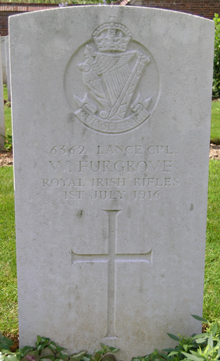| Regiment/Service: |
12th Battalion, Royal Irish Rifles (British Army) |
| Died: |
01/07/1916 (Killed in Action) |
| Age: |
28 |
|
|
William Furgrove was the only son of William and Ellen Furgrove. William was born in Moneymore about 1888. Both census’ lists the family name as Forgrave. By 1901, the family lived in Moylarg, Galgorm, Antrim, near Cullybackey. When war broke out, William Furgrove went to Ballymena to enlist into the 12th Battalion Royal Irish Rifles. They did much of their training at Clandeboye and Seaford, before they were sent to France in October 1915. Their first major engagement with the enemy was to be the Somme Offensive. Lance Corporal William Furgrove was killed in action at the Somme on the 1st July 1916. He was aged about 28.
|

|
|

|
|
|
|
The village of Beaumont-Hamel was attacked on 1 July 1916 by the 29th Division, with the 4th on its left and the 36th (Ulster) on its right, but without success. On 3 September a further attack was delivered between Hamel and Beaumont-Hamel and on 13 and 14 November, the 51st (Highland), 63rd (Royal Naval), 39th and 19th (Western) Divisions finally succeeded in capturing Beaumont-Hamel, Beaucourt-sur-Ancre and St. Pierre-Divion. Following the German withdrawal to the Hindenburg Line in the spring of 1917, V Corps cleared this battlefield and created a number of cemeteries, of which Ancre British Cemetery (then called Ancre River No.1 British Cemetery, V Corps Cemetery No.26) was one. There were originally 517 burials almost all of the 63rd (Naval) and 36th Divisions, but after the Armistice the cemetery was greatly enlarged when many more graves from the same battlefields and from the following smaller burial grounds.
|
|

|
|
|
